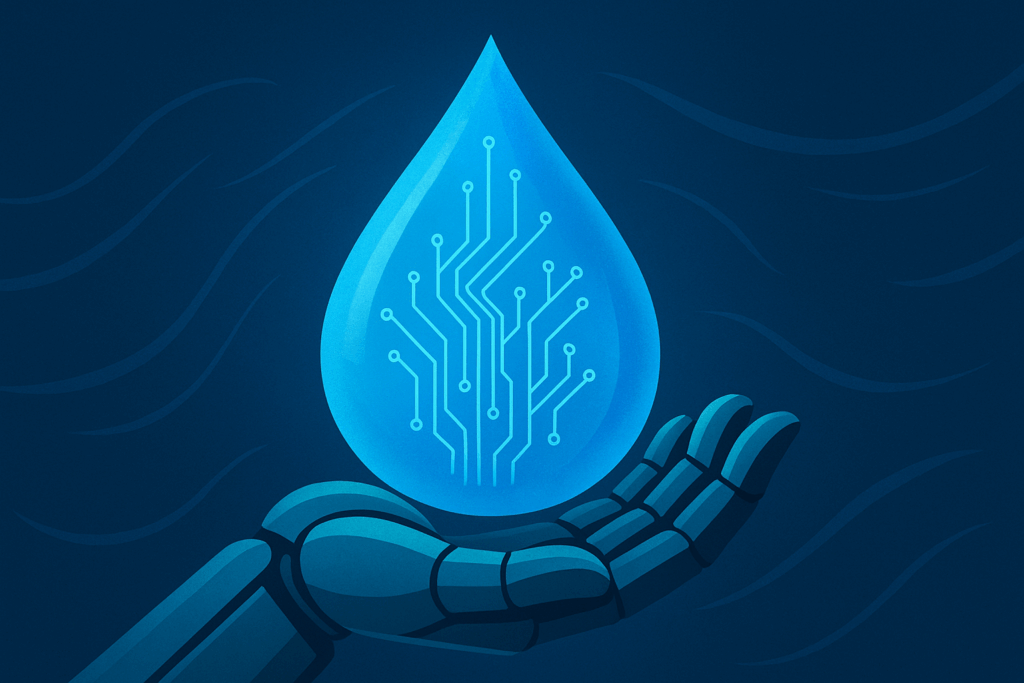Have you ever wondered what happens if you ask AI to create an image, write a poem, or draft an email?
Most of us picture “the cloud” working its magic in a distant location. The twist is that the cloud is physical, real, and thirsty. Data centers require water, sometimes millions of gallons per day, to stay cool while AI is operating.
By 2025, it is impossible to overlook AI’s growing water footprint. But don’t worry, AI isn’t to blame here. It’s about comprehending the problem, the ingenious ways technology is attempting to solve it, and what we (as humans) can do to improve the situation.
Why does AI need water?
Doesn’t your laptop heat up quickly when you run it on overdrive for hours? Now multiply that by millions of machines that are constantly in operation and stacked in enormous warehouses. A data centre is that.
These facilities are cooled by air conditioning units, liquid cooling, or evaporative cooling to avoid overheating. And gallons of fresh water are lost every day due to evaporative cooling, in which water actually evaporates into the atmosphere to remove heat.
Therefore, there is an invisible cost associated with every chatbot interaction, artificial intelligence-powered search, and generated image: water.
How big is the problem in 2025?
Pretty Big—and expanding. According to a 2025 industry report, data centers related to artificial intelligence may use more than 6 billion cubic meters of water a year by the end of this decade. That is roughly equivalent to the annual consumption of a mid-sized nation.

In short, AI’s water consumption is no longer a “future problem.” The effects are already being felt by the communities that surround big data centers. Concerns regarding water stress during dry months have been voiced by residents in places like Arizona and Ireland.
But wait—can AI help solve this?
Surprisingly, yes. It is being saved by the same intelligence that requires water.
optimised cooling: Businesses are utilising AI to operate data centers more effectively by anticipating precisely when and how much cooling is required, which can reduce water waste by as much as 20–30%.
Technology for liquid cooling: Some new servers are moving to liquid cooling systems, which consume a lot less water than conventional techniques.
Green data centers: Major corporations, such as Google and Microsoft, are testing facilities that use recycled water rather than fresh water for cooling and are powered by renewable energy.
Therefore, “AI is the problem” is not the story. “AI is thirsty, but also learning how to drink smarter,” it says.
What about us—can regular people help?
Absolutely.Our decisions have an impact even though the majority of us do not manage data centers. Here’s how:
More intelligent use of AI: We can be aware of how frequently we execute complex AI tasks, just as we try to conserve energy. (Is 50 AI-generated versions of the same image really necessary?)
Encourage green tech: Selecting platforms and services that are dedicated to sustainable data practices encourages the sector to improve.
Community action: Cities can enact laws that promote the use of recycled water in data centers and openness regarding the effects of water use in their communities.
Consider it similar to electricity, whose hidden costs we initially hardly noticed. Efficiency and awareness, however, had a significant impact over time. Water and AI can have the same effect.
What’s the bigger picture?
AI is only one piece of the global water puzzle. Water stress is still primarily caused by industry, agriculture, and climate change. However, the emergence of AI makes us reevaluate how we want to engage with the planet’s most valuable resource in the digital future.
If this is done correctly, artificial intelligence (AI) has the potential to be a partner in sustainability, not only in terms of how it uses water but also in terms of how it aids in global water monitoring, forecasting, and conservation.
The Takeaway
The cloud isn’t magic. It’s water, energy, wires, and metal. And AI’s thirst increases with its growth. However, this is an opportunity for creativity rather than panic. Communities, engineers, and even artificial intelligence (AI) are already rethinking how to keep machines cool without depleting the planet.
Therefore, keep in mind that every pixel and word contains a hidden drop of water the next time you converse with AI or create an interesting image. Furthermore, the more information we have, the better decisions we can make to ensure the future continues.
Source: Read MoreÂ
